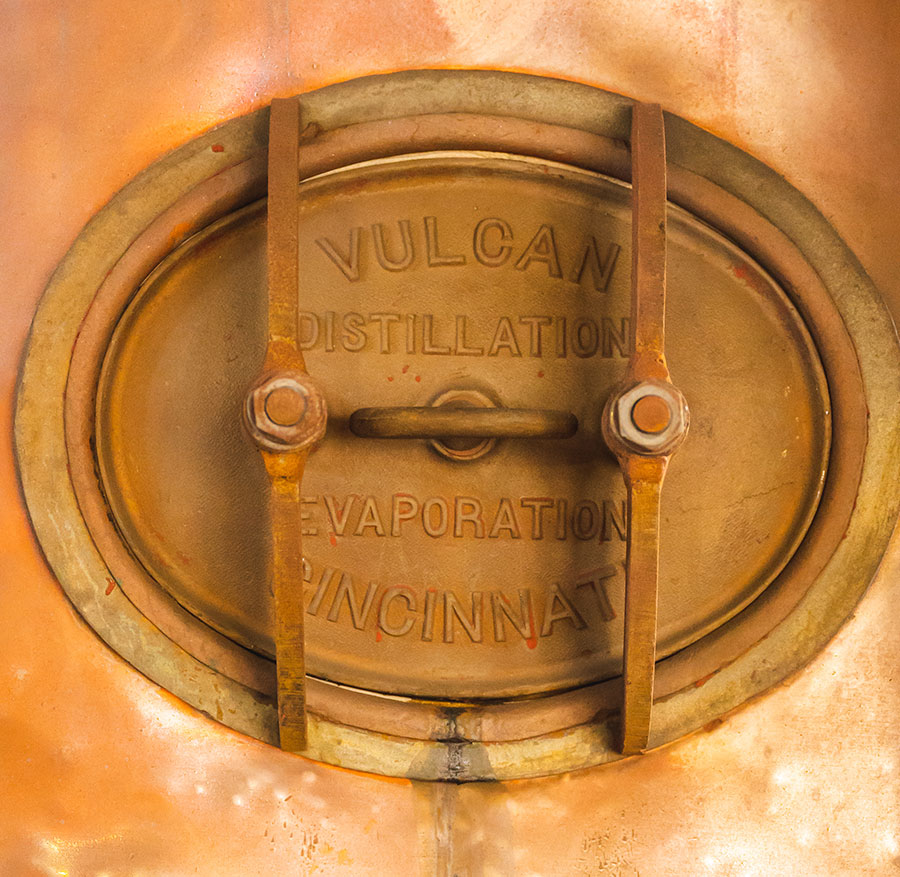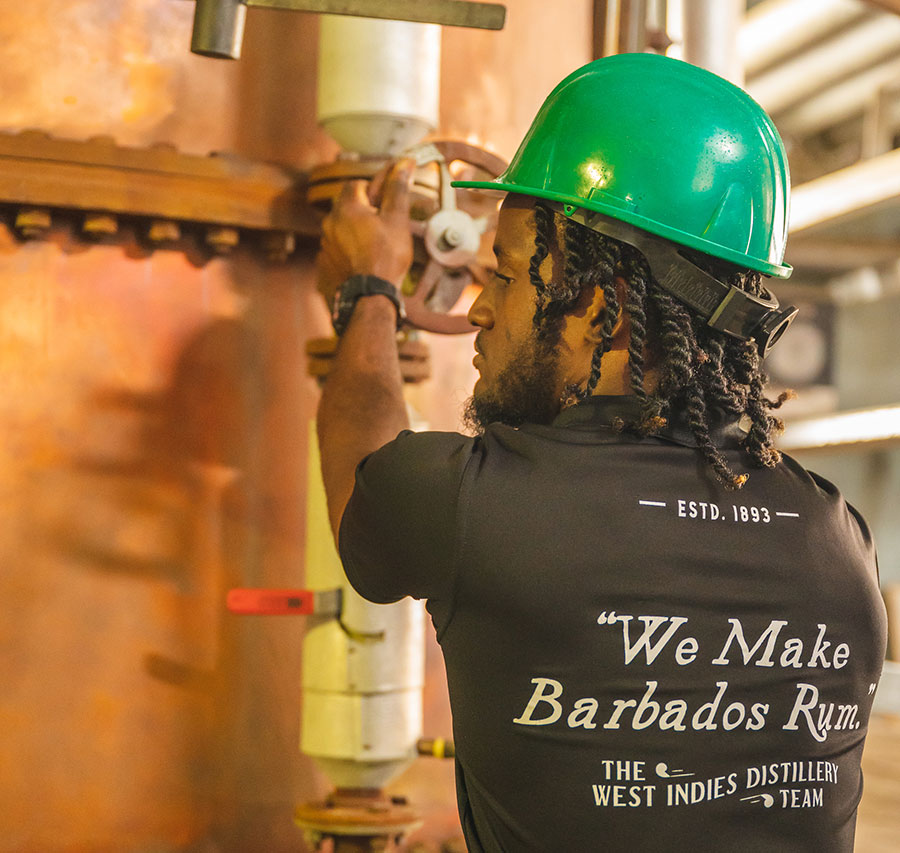A host of technical inventions have allowed the passage from the terracotta alembic of Tepe Gawra (3rd millennium B.C.) to the immense fully automated distilling columns of our time. Today, there is relatively little evidence of the diversity that still exists in rum in terms of distillation apparatus. However, several distilleries still use venerable machines, and even mix columns and stills. Others even go as far as restoring them, and putting them back into service.
John Dore, Barbet, Vulcan, Rockley, Kettle, Stades, Coffey, Savalle… if you are a rum lover, these names must tell you something and evoke images of long metal towers, heavy copper cauldrons, elegant swan necks (or elephant trunks), vapors, and delicious brandies of course.
The history of spirits in general, and rum in particular, is littered with brilliant inventors who have developed stills and columns, each more qualitative and efficient than the last. Some of them, few in number, have survived and continue to produce rum.
The beginnings of distillation
It all began in Tepe Gawra in Mesopotamia (now Iraq) in the 3rd millennium BC. It is there that the oldest known distillation apparatus was found. The Babylonians had understood that by heating a liquid contained in an earthen vessel with a conical lid, it could be evaporated and then condensed. The foundations of distillation were laid, but it was still far from alcoholic distillation. Instead, balsams and essential oils were made with these rudimentary stills. The process was improved by the Greeks (Aristotle mentions it in the 4th century BC).
It was then adopted by the Muslim world. In the 8th century, the scientist Jabir Ibn Hayyan or Geber would be the inventor (as well as many laboratory tools) of a slightly more advanced alembic (or ‘al’inbïq’). Considered the father of chemistry, he was also the first to notice that the vapors from the distillation of wine could ignite. Hence the Latin word aqua ardens or water that catches fire, which became aguardiente in Spanish. Al-Razi or Rhazes, will then discover ethanol around the year 900, then Ibn Sina or Avicenna will perfect the distillation process around the year 1000.
In particular the condensation of steam to collect the precious liquid. Via Spain, then under the control of the Umayyads and the Crusades, Europeans took over the process and Arnaud de Villeneuve, a doctor and theologian in Toulouse (1240-1311), is said to have been the first to distil wine brandy. Thus was born aqua vitae, brandy, which was then used as a medicine and not to be drunk. But this was soon to change.
The first rums are produced with the help of stills
Very quickly the new technology spread throughout Europe (notably via universities and abbeys). In the 14th century, English and Dutch merchants, who bought large volumes of wine from Aquitaine (Bordeaux and Charente), got hold of it.
They distilled the wine so that it would be able to cross the seas and time (otherwise it would turn sour). This is the birth of Brandwin or Brandy, which will later become Cognac. And when, following Christopher Columbus (1491), the Europeans set out to colonize the Caribbean and the Americas, they took stills with them, which would allow them to distill molasses or cane juice.
This will give birth to rum. There are few traces left of these ancient stills, many of which were partially built of wood, many of which were even made of copper, which must have exploded and suffered irreparable damage over time.
Each era brings its own set of technical advances
Thus, in the 16th century, stills were gradually equipped with swan necks that allowed for a better collection and concentration of alcohol vapors, and with coils that helped refrigerate these vapors to transform them into liquid (the spirit).
The technique of double distillation (and even triple distillation in the case of Irish whiskey) is also spreading. In short, it consists in redistilling a brouillis that has already been distilled once, in order to obtain a much more concentrated spirit with a much higher alcohol content.
The overall quality of whiskies, cognacs and rums improves. If we are to believe Father Labat (1663 – 1738), the Caribbean islands under English rule were then technically much more advanced than those dominated by the French. The fact remains that the wars that pushed the regions into the arms of such and such a nation favored exchanges. Thus, the Dutch and Danes, even if they lost control of their possessions, took root there and participated in the technical improvement of rum distillation.
The appearance of the distillation column
But it is really in the 19th century that the technical advances will be the most obvious and the most impactful. Most of the oldest machines still in use in rum distilleries date from this period. It is also the era of genius manufacturers, whose names have been passed on to posterity: John Dore, Georges Stades, Aneas Coffey…
It is the latter who will truly revolutionize the nascent spirits industry by filing a patent that improves an invention of Robert Stein, the patent still, or distilling column (1828). The distilling column, which allows to produce continuously and not in two times, therefore faster and at a higher degree, begins to spread throughout the world.
If the pot still resists in some lands dominated by the English, the column becomes preponderant, even hegemonic in the French dominions (Martinique, Guadeloupe and Reunion) and Spanish. Some rum-producing countries, such as Barbados or Jamaica, now use both.
End of diversity, and revival
From the 1930s onwards, many pot stills and old columns fell into disuse and were scrapped, while distilleries all over the rum world were closing down. The rum industry will continue to concentrate until today. So much so that the incredible diversity that reigned at the time disappeared little by little.
However, some distilleries continue to use several types of machinery and even both columns and stills, which sometimes come from distilleries that have closed. Demerara Distillers, of course, West Indies Rum Distillery (Barbados), DUSA (Venezuela), Bielle (Marie-Galante)… While others, such as Saint James, are thinking of leaving the all-columns to equip themselves with a still.
And the use of such or such still or column, becomes a sales argument and differentiation, which appears more and more on the labels. Sometimes even in the form of drawings, as on some Velier vintages such as the Forsyths Worthy Park 2006 WPM 57.5% or the Papa Royo White.
We also think of the numbered vintages of Diplomatico: N° 1 Batch Kettle, N° 2 Barbet and N° 3 Pot Still. We also see more and more hybrid stills (between pot still and columns) appearing. Like the Guadeloupean neo-distillery Papa Rouyo, or A1710 in Martinique, the use of the pot still in column land is becoming a differentiating argument, and to some extent a return to the roots.
The rise of rum distillation in France has brought back to the forefront old stills (Cognac, Vosges…) initially used to distill cognac, whisky, brandies, fruit… In short, we feel a tremor, a quiet return to diversity, while some old mythical machines from the 1800s and 1900s are restored and start singing again.
To visit: The still museum at Saint James
In Martinique, Michel Fayad watches over a real treasure. Over the years, Saint James has preserved or recovered a number of old distillation columns, which are displayed in the open air in the museum’s garden.
There is also a still museum, with many pieces, not all of which were used to distill rum. We also recommend a visit to the La Salle house, which is an exact replica of an 18th century sugar house. And why not take the plantation train from the museum to La Salle.
The Saint James boutique, the museum and the La Salle House are open Monday through Sunday from 9 a.m. to 5 p.m. 7 VC de Bezaudin, Sainte-Marie 97230, Martinique


